Air to Water Generator Integrated System Real Application: A Study Case in a Worker Village in United Arab Emirates
Abstract
1. Introduction
- the case study described by authors in ref. [20], which provided a methodological approach refined and used in the current study;
- the experience reported in ref. [21], which used the same machine subject of the current work but only for water quality analyses purposes;
- the test performed in ref. [22], where it was tried to improve the water yield, increasing the vapour content in the air by means of adiabatic cooling.
- more data about large-sized integrated AWG real tests;
- HVAC retrofitting potentialities by means of integrated AWG;
- extended economic evaluations, taking into account the water quality and the particularity of the integration (HVAC contributions);
- considerations about plastic saving.
- the machine behaviour during an entire year, tuning the physically based model used in ref. [20];
- revamping potentialities of the existing HVAC plant;
- economic analyses, carried out considering the integration advantages and the quality of the produced water;
- plastic savings potentialities.
2. AWG Technologies
- a certain quantity of condensed water;
- a cooled and dried airflow that can be directly employed as primary air or convoyed into an Air Handling Unit (AHU) of an air conditioning system;
- a flux of heating energy, which can be used to heat up, for example, domestic water.
3. Methodology
- Data collection: the case study section reports information about the test site and the characteristics of the possible buildings to be served by the integrated machine. Moreover, needs about drinking water, primary air and thermal heating for domestic water were described too. Data concerning the existing plants were also collected, as well as costs about drinking water and energy sources.
- Weather environmental conditions: statistical hourly data about temperature and relative humidity from a weather station placed in Dubai, at only 5 km from the installation spot, were collected in order to have the climatic conditions of an entire statistical year. A brief analysis of the weather data frequency was also added.
- Integrated system behaviour analyses: the behaviour of the machine, installed nearby the kitchens building, was monitored by the data collection in some time periods. On the basis of such data, the simulator, used in ref. [20], was fine-tuned and run using the Dubai climate conditions, collected by means of the said weather station in order to determine how the machine was expected to behave all over the year in terms of produced water, energy consumption, heating power/energy and cooling power/energy. In order to evaluate the energy efficiency of the machine, in terms of produced water and consumed energy, the Water Energy Transformation (WET) indicator was employed [37].
- Covered needs: matching the integrated machine behaviour in the Dubai weather and the needs (drinking water, primary air and domestic water heating), it was calculated how many buildings it was possible to serve.
- Economic evaluations: all the voices, positive and negative, related to the machine installation and its use, were collected and the Pay Back Time (PBT) calculated. Moreover, the Net Present Value and the actualised Pay Back Time were calculated, because the installation can be seen as a sort of investment.
- plastic savings: on the basis of the literature data, savings in terms of avoided plastic bottles were calculated.
4. Case Study
4.1. Geographical Site, Buildings, Existing Plants and Energy and Water Supply
4.2. Bottled Water Cost
4.3. Electricity Cost
4.4. LPG Cost
4.5. Weather Conditions
5. Integrated Machine: Description, Plant Linking and Behaviour Analyses
5.1. Integrated Machine Description
- Air filters placed in the inlet section. The air coming from the environment is cleaned by means of a filtration stage composed by two filter arrays in series: the first composed by coarse filters followed by pocket filters in order to avoid pollution due to dust, sand, insects, bacteria and other particles.
- Evaporation and heat recovery coils. The cooling process is carried out by means of direct cooling on an evaporation coil combined with a heat recovery system. Both of them are made of food contact materials [48]. The airflow, after the cooling process, can be collected in a duct in order to be delivered to zones requiring cooled and dry air changes.
- Evaporation fans. The machine has centrifugal evaporation fans that can provide an average airflow, in Dubai conditions, of 10,000 m3/h.
- Screw Compressor. The compressor running the thermodynamic reverse cycle is a screw compressor having, in Dubai environmental conditions, an average cooling and heating capacity, respectively, of 81 kW and 105 kW. The coolant is R134a.
- Condensation coils. The machine is equipped by two kinds of condenser: a finned air-cooled coil and a plate heat exchanger. The condensation heat is delivered to the domestic water by means of this second condenser, where the water flow is run by a pump, regulated by the setting temperature. When heating is not required, the condensation is provided by the fined coil, cooled by the environmental air. The plate heat exchanger works with a classic temperature difference of 5 °C. The domestic water heating was set to obtain a temperature difference of 40 °C and a maximum temperature of 50 °C.
- Water treatment unit. The condensate coming from the evaporator is collected in a tank in stainless steel. After that, the liquid is processed in a multistage system comprising mechanical filtration made by three stages with decreasing meshes, the last one having a mesh of 1 μm, activated carbon filter, adsorption resins, UV (ultraviolet) lamps, reverse osmosis and a mineralisation stage. The system is continuously monitored by means of a pH probe and a conductivity probe and a water meter dedicated to count the produced water.
5.2. Integrated Machine Plant Linking
5.3. Integrated Machine Behaviour and Needs Coverage
- It covers entirely the heating needs of domestic water of two residential buildings, substituting the electrical boilers and providing, in such a way, an electrical energy saving of 634,509.5 kWh/year, which is 100% of the whole energy consumption;
- It covers partially the kitchen heating needs of domestic water, providing an average of 70% of the required heating, leaving to the LPG boiler the residual heating work, giving, thus, LPG saving of 54,426.1 L/year;
- It helps the air conditioning system, providing a treated airflow and giving a cooling energy equal to 665,908.4 kWh, providing, in this case, an electrical energy saving of 190,259.5 kWh/year and 87% of the required fresh air.
6. Economic Evaluations
7. Plastic Saving
8. Discussion, Implications and Future Developments
9. Conclusions
Author Contributions
Funding
Institutional Review Board Statement
Informed Consent Statement
Data Availability Statement
Acknowledgments
Conflicts of Interest
Abbreviations
| Acronyms | |
| AED | ISO code for Dirham |
| AHU | Air Handling Unit |
| AWG | Air to Water Generator |
| AWH | Air Water Harvesting |
| COP | Coefficient of Performance |
| EER | Energy Efficiency Ratio |
| HVAC | Heating Ventilation Air Conditioning |
| ICP | Inferior Calorific Power |
| LPG | Liquid Petroleum Gas |
| NPV | Net Present Value |
| PBT | Pay Back Time |
| PET | PolyEthylene Terephthalate |
| PLC | Programmable Logic Controller |
| WET | Water Energy Transformation |
| UAE | United Arab Emirates |
| UN | United Nations |
| UV | Ultra Violet |
| Symbols | |
| a | dry air mass flow (kg/s) |
| C | water specific heat, 4.186 kJ/(kgK) |
| Cp | Inferior Calorific Power (kWh/L) |
| Cu | net cash flow (chosen currency) |
| en | energy (kWh) or (kJ) |
| ent | heating energy (kWh) or (kJ) |
| enel | electrical energy (kWh) or (kJ) |
| i | actualisation rate (%) |
| j | calculation model node number |
| m | water mass (kg) |
| N | time horizon (years) |
| q | water mass-flow (kg/s) |
| Qc | condensation energy (kJ) |
| R | coolant mass (kg) |
| r | coolant mass flow (kg/s) |
| R.H. | relative humidity (%) |
| t | dry bulb temperature (°C) |
| V(N) | residual value of the considered good at after the time horizon (chosen currency) |
| v | LPG volume (L) |
| η | efficiency (−) |
| τ | time period (year) or time step (s) |
| φ | energy flux (kW) |
| z | index of the mass flow or energy flow exchange in the node |
Appendix A
References
- UNESCO World Water Assessment Programme. UN World Water Development Report 2019: Leaving No One Behind; UNESCO: Paris, France, 2019; ISBN 978-92-3-100309-7. [Google Scholar]
- Global Land Outlook, United Nations Convention to Combat Desertification. 2017. Available online: https://knowledge.unccd.int/glo/global-land-outlook-glo (accessed on 27 December 2021).
- Water Consumption. Available online: https://www.worldometers.info/water/ (accessed on 27 December 2021).
- WHO Drinking Water. Available online: https://www.who.int/news-room/fact-sheets/detail/drinking-water (accessed on 15 February 2022).
- UNICEF Stories, Water and the Global Climate Crisis: 10 Things You Should Know. Available online: https://www.unicef.org/stories/water-and-climate-change-10-things-you-should-know (accessed on 20 June 2022).
- Water Economy Report UNESCO. Available online: http://www.unesco.org/reports/wwdr/2021/en/valuing-water-economy (accessed on 29 December 2021).
- Karimidastenaei, Z.; Avellán, T.; Sadegh, M.; Kløve, B.; Haghighi, A.T. Unconventional water resources: Global opportunities and challenges. Sci. Total Environ. 2022, 827, 154429. [Google Scholar] [CrossRef] [PubMed]
- Zhang, M.; Liu, R.; Li, Y. Diversifying Water Sources with AtmosphericWater Harvesting to Enhance Water Supply Resilience. Sustainability 2022, 14, 7783. [Google Scholar] [CrossRef]
- Algarni, S.; Saleel, C.A.; Mujeebu, M.A. Air-conditioning condensate recovery, and applications—Current developments and challenges ahead. Sustain. Cities Soc. 2018, 37, 263–274. [Google Scholar] [CrossRef]
- Ansari, E.; Ferber, N.L.; Milošević, T.; Barron, J.; Karanikolos, G.N.; Faisal AlMarzooqi, F.; Dumée, L.F.; Calvet, N. Atmospheric water generation in arid regions—A perspective on deployment challenges for the Middle East. J. Water Process Eng. 2022, 49, 103163. [Google Scholar] [CrossRef]
- Government of Dubai. Green Building Regulations and Specifications; Dubai Electricity and Water Authority: Dubai, United Arab Emirates, 2011. Available online: https://www.dewa.gov.ae/~/media/Files/Consultants%20and%20Contractors/Green%20Building/Greenbuilding_Eng.ashx (accessed on 28 March 2022).
- Purushothama, B. 11—Air-conditioning units. In Humidification and Ventilation Management in Textile Industry; Woodhead Publishing: Delhi, India, 2009; pp. 174–193. ISBN 9788190800129. [Google Scholar] [CrossRef]
- Raveesh, G.; Goyal, R.; Tyagi, S. Advances in atmospheric water generation technologies. Energy Convers. Manag. 2021, 239, 114226. [Google Scholar] [CrossRef]
- Wang, Y.; Danook, S.H.; Al-Bonsrulah, H.A.; Veeman, D.; Wang, F. A Recent and Systematic Review on Water Extraction from the Atmosphere for Arid Zones. Energies 2022, 15, 421. [Google Scholar] [CrossRef]
- Liu, X.; Beysens, D.; Bourouina, T. Water Harvesting from Air: Current Passive Approaches and Outlook. ACS Mater. Lett. 2022, 4, 1003–1024. [Google Scholar] [CrossRef]
- Pokorny, N.; Shemelin, V.; Novotny, J. Experimental study and performance analysis of a mobile autonomous atmospheric water generator designed for arid climatic conditions. Energy 2022, 250, 123813. [Google Scholar] [CrossRef]
- Bagheri, F. Performance investigation of atmospheric water harvesting systems. Water Resour. Ind. 2018, 20, 23–28. [Google Scholar] [CrossRef]
- Shahrokhi, F.; Esmaeili, A. Optimizing relative humidity based on the heat transfer terms of the thermoelectric atmospheric water generator (AWG): Innovative design. Alex. Eng. J. 2023, 67, 143–152. [Google Scholar] [CrossRef]
- Wang, W.; Yang, T.; Pan, Q.; Dai, Y.; Wang, R.; Ge, T. All-day freshwater production enabled by an active continuous sorption-based atmospheric water harvesting system. Energy Convers. Manag. 2022, 264, 115745. [Google Scholar] [CrossRef]
- Cattani, L.; Magrini, A.; Cattani, P. Water Extraction from Air by Refrigeration—Experimental Results from an Integrated System Application. Appl. Sci. 2018, 8, 2262. [Google Scholar] [CrossRef]
- Mandal, C.S.; Agarwal, M.; Reddy, V.; Kudapa, V.K. Water from air—A sustainable source of water. Mater. Today Proc. 2020, 46, 3352–3357. [Google Scholar] [CrossRef]
- Kgatla, L.; Gidudu, B.; Chirwa, E.M.N. Feasibility Study of Atmospheric Water Harvesting Augmented through Evaporative Cooling. Water 2022, 14, 2983. [Google Scholar] [CrossRef]
- Moghimi, F.; Ghoddusi, H.; Asiabanpour, B.; Behroozikhah, M. Is atmospheric water generation an economically viable solution? Clean Technol. Environ. Policy 2021, 23, 1045–1062. [Google Scholar] [CrossRef]
- Asim, N.; Badiei, M.; Mohammad, M.; Razali, H.; Rajabi, A.; Haw, L.C.; Ghazali, M.J. Sustainability of Heating, Ventilation and Air-Conditioning (HVAC) Systems in Buildings—An Overview. Int. J. Environ. Res. Public Health 2022, 19, 1016. [Google Scholar] [CrossRef]
- Tu, Y.; Wang, R.; Zhang, Y.; Wang, J. Progress and Expectation of Atmospheric Water Harvesting. Joule 2018, 2, 1452–1475. [Google Scholar] [CrossRef]
- Sharan, G.; Roy, A.K.; Royon, L.; Mongruel, A.; Beysens, D. Dew plant for bottling water. J. Clean. Prod. 2017, 155, 83–92. [Google Scholar] [CrossRef]
- Atmospheric Water Generator or Water-from-Air Machine Suppliers Links. Available online: http://www.atmoswater.com/manufacturers-and-suppliers-of-atmospheric-water-generators--water-from-air-machines.html (accessed on 5 January 2022).
- Magrini, A.; Cattani, L.; Cartesegna, M.; Magnani, L. Water Production from Air Conditioning Systems: Some Evaluations about a Sustainable Use of Resources. Sustainability 2017, 9, 1309. [Google Scholar] [CrossRef]
- Milani, D.; Abbas, A.; Vassallo, A.; Chiesa, M.; Al Bakri, D. Evaluation of using thermoelectric coolers in a dehumidification system to generate freshwater from ambient air. Chem. Eng. Sci. 2011, 66, 2491–2501. [Google Scholar] [CrossRef]
- Asham, A.D.; Abdelaal, W.G.A.; Mamdouh, W.M. A Novel Ambiently Adaptive Atmospheric Water Generator Using Maximum Production Tracking Algorithm. Teh. Vjesn. Tech. Gaz. 2022, 29, 797–805. [Google Scholar] [CrossRef]
- Fathieh, F.; Kalmutzki, M.J.; Kapustin, E.A.; Waller, P.J.; Yang, J.; Yaghi, O.M. Practical water production from desert air. Sci. Adv. 2018, 4, eaat3198. [Google Scholar] [CrossRef] [PubMed]
- Zhao, F.; Zhou, X.; Liu, Y.; Shi, Y.; Dai, Y.; Yu, G. Super Moisture-Absorbent Gels for All-Weather Atmospheric Water Harvesting. Adv. Mater. 2019, 31, 1806446. [Google Scholar] [CrossRef]
- Shemelin, V.; Pokorny, N.; Novotny, J. Experimental investigation of silica gel and zeolite coated fin-tube heat exchangers under arid climatic conditions. Energy Rep. 2022, 8, 331–341. [Google Scholar] [CrossRef]
- Yang, K.; Pan, T.; Lei, Q.; Dong, X.; Cheng, Q.; Han, Y. A Roadmap to Sorption-Based Atmospheric Water Harvesting: From Molecular Sorption Mechanism to Sorbent Design and System Optimization. Environ. Sci. Technol. 2021, 55, 6542–6560. [Google Scholar] [CrossRef]
- Wasti, T.Z.; Sultan, M.; Aleem, M.; Sajjad, U.; Farooq, M.; Raza, M.H.; Khan, M.; Noor, S. An overview of solid and liquid materials for adsorption-based atmospheric water harvesting. Adv. Mech. Eng. 2022, 14, 1–27. [Google Scholar] [CrossRef]
- Mulchandani, A.; Edberg, J.; Herckes, P.; Westerhoff, P. Seasonal atmospheric water harvesting yield and water quality using electric-powered desiccant and compressor dehumidifiers. Sci. Total. Environ. 2022, 825, 153966. [Google Scholar] [CrossRef]
- Cattani, L.; Magrini, A.; Cattani, P. Water Extraction from Air: A Proposal for a New Indicator to Compare Air Water Generators Efficiency. Energies 2021, 14, 224. [Google Scholar] [CrossRef]
- Cattani, L.; Cattani, P.; Magrini, A. Air to Water Generator Integrated Systems: The Proposal of a Global Evaluation Index—GEI Formulation and Application Examples. Energies 2021, 14, 8528. [Google Scholar] [CrossRef]
- Pacak, A.; Jurga, A.; Drąg, P.; Pandelidis, D.; Kaźmierczak, B. A Long-Term Analysis of the Possibility of Water Recovery for Hydroponic Lettuce Irrigation in Indoor Vertical Farm. Part 1: Water Recovery from Exhaust Air. Appl. Sci. 2020, 10, 8907. [Google Scholar] [CrossRef]
- Khalid, M.B.; Beithou, N.; Al-Taani, M.; Andruszkiewicz, A.; Alahmer, A.; Borowski, G.; Alsaqoor, S. Integrated Eco-Friendly Outdoor Cooling System—Case Study of Hot-Humid Climate Countries. J. Ecol. Eng. 2022, 23, 64–72. [Google Scholar] [CrossRef]
- Labour Accommodation in United Arab Emirates. Available online: https://u.ae/en/information-and-services/jobs/labour-accommodation (accessed on 17 February 2023).
- Mineral Water Cost in Emirates. Available online: https://www.globalproductprices.com/United-Arab-Emirates/mineral_water_prices/ (accessed on 15 March 2022).
- Currency Rates. Available online: https://it.investing.com/currencies/aed-eur-historical-data (accessed on 28 March 2022).
- Emirates Electricity Costs Calculator. Available online: https://www.dewa.gov.ae/en/consumer/billing/tariff-calculator (accessed on 28 March 2022).
- ADNOC LPG Refilling Prices. Available online: https://www.adnocdistribution.ae/en/products-services/gas/liquefied-petroleum-gas-lpg/overview/ (accessed on 28 December 2022).
- Weatherbase, Weather Data. Available online: https://www.weatherbase.com/weather/weather-summary.php3?s=49114&cityname=Dubai,+United+Arab+Emirates (accessed on 7 January 2022).
- Cattani, L.; Magrini, A.; Leoni, V. Energy Performance of Water Generators from Gaseous Mixtures by Condensation: Climatic Datasets Choice. Energies 2022, 15, 7581. [Google Scholar] [CrossRef]
- Food Contact Materials Definition, European Food Safety Authority. Available online: https://www.efsa.europa.eu/en/topics/topic/food-contact-materials (accessed on 16 December 2022).
- Emirate Bonds. Available online: https://www.boerse-frankfurt.de/bond/xs0885065887-emirates-4-5-13-25 (accessed on 9 January 2023).
- Inflation rate previsions. Available online: https://www.statista.com/statistics/297779/uae-inflation-rate/ (accessed on 28 December 2022).
- Becerril-Arreola, R.; Bucklin, R.E. Beverage bottle capacity, packaging efficiency, and the potential for plastic waste reduction. Sci. Rep. 2021, 11, 3542. [Google Scholar] [CrossRef]
- Cattani, L.; Cattani, P.; Magrini, A. Photovoltaic Cleaning Optimization: A Simplified Theoretical Approach for Air to Water Generator (AWG) System Employment. Energies 2021, 14, 4271. [Google Scholar] [CrossRef]
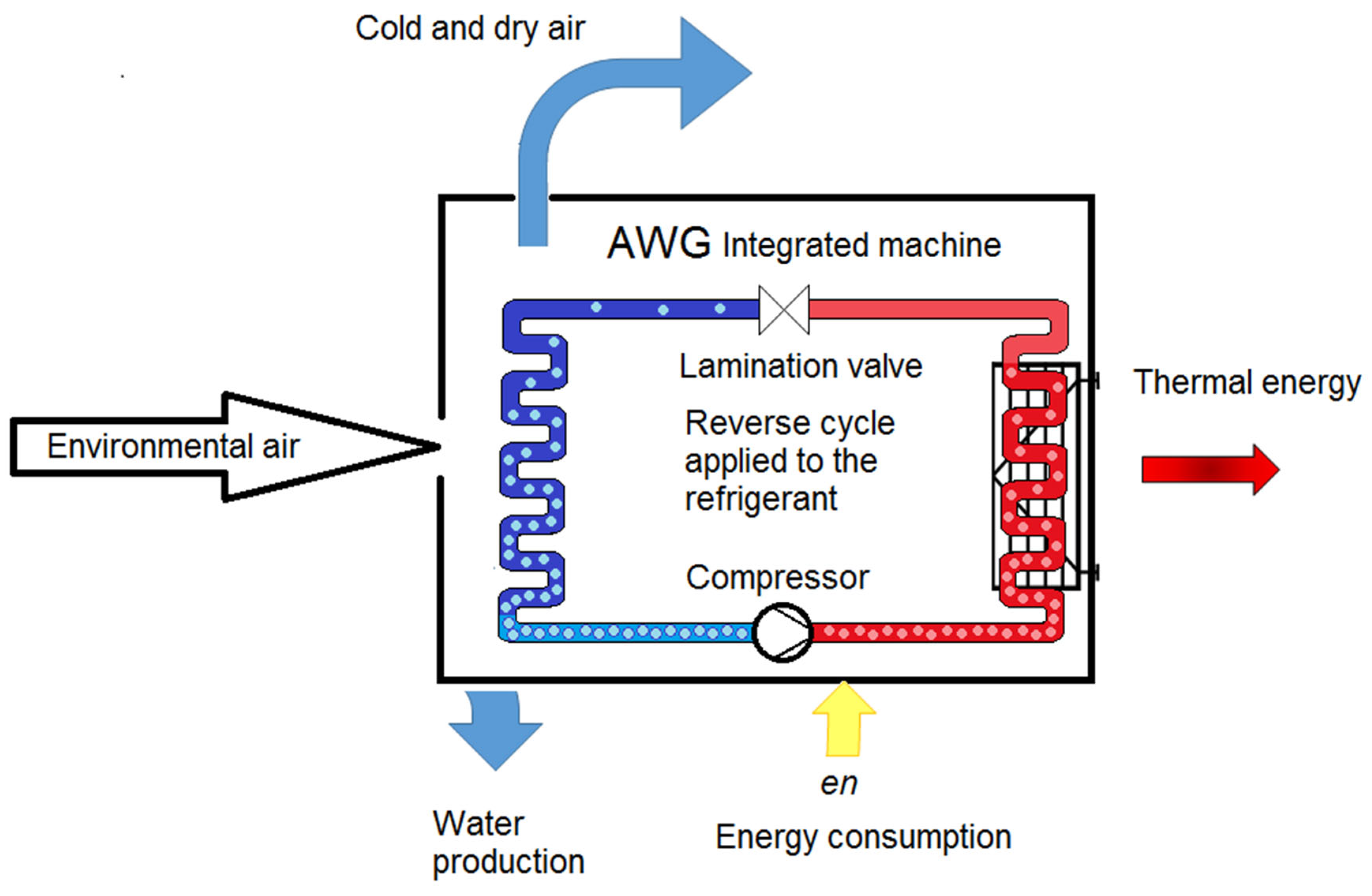
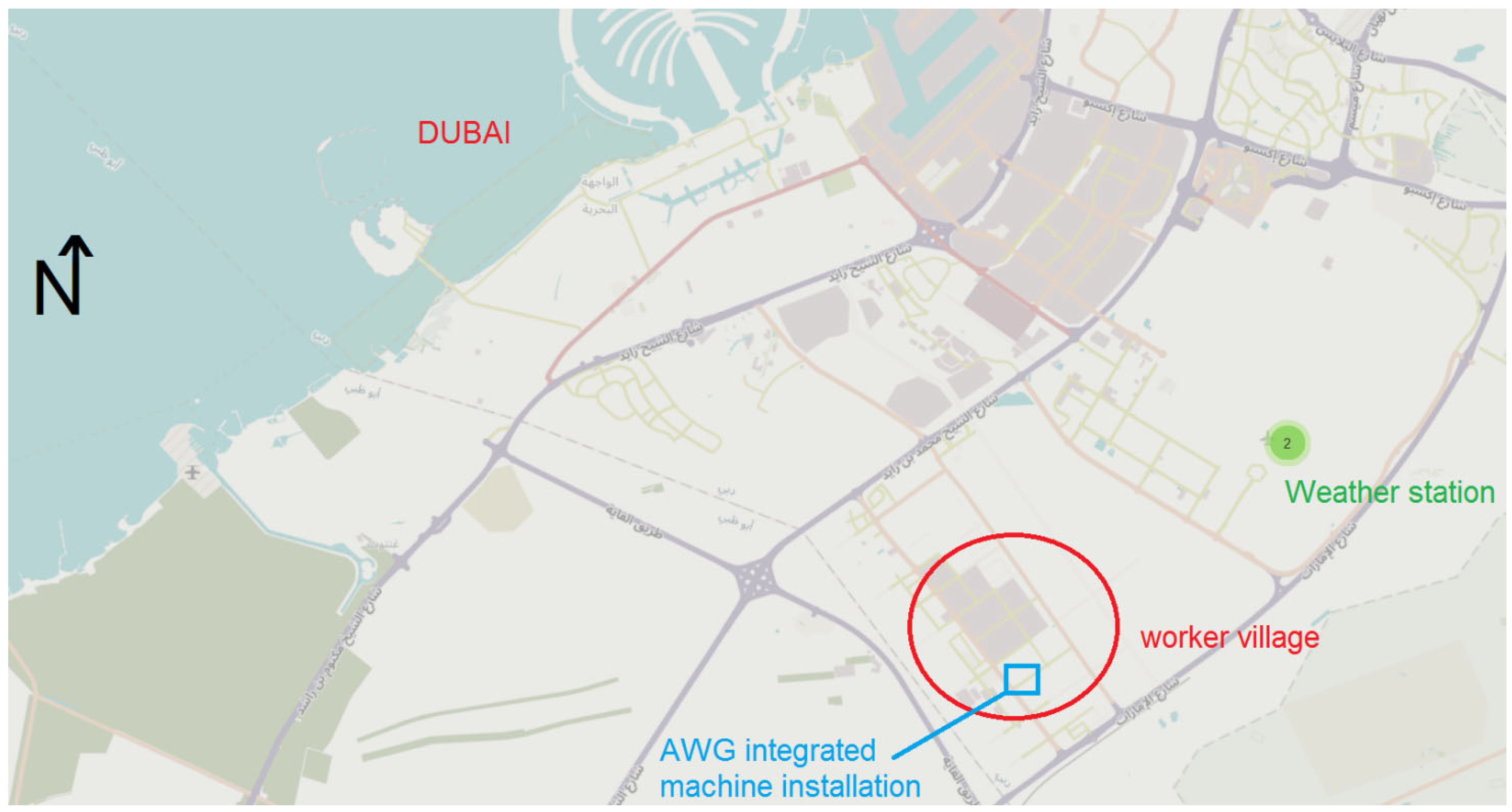



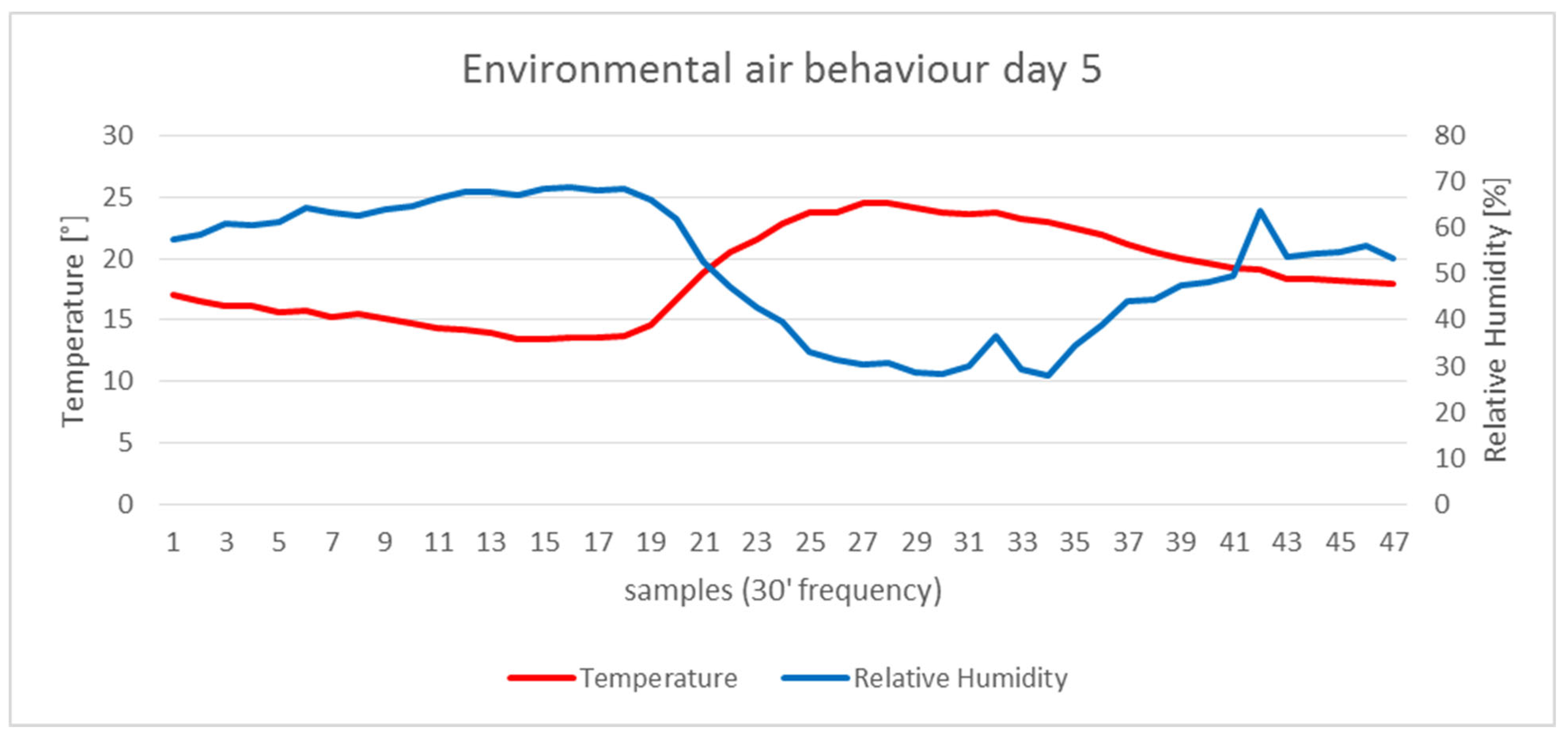
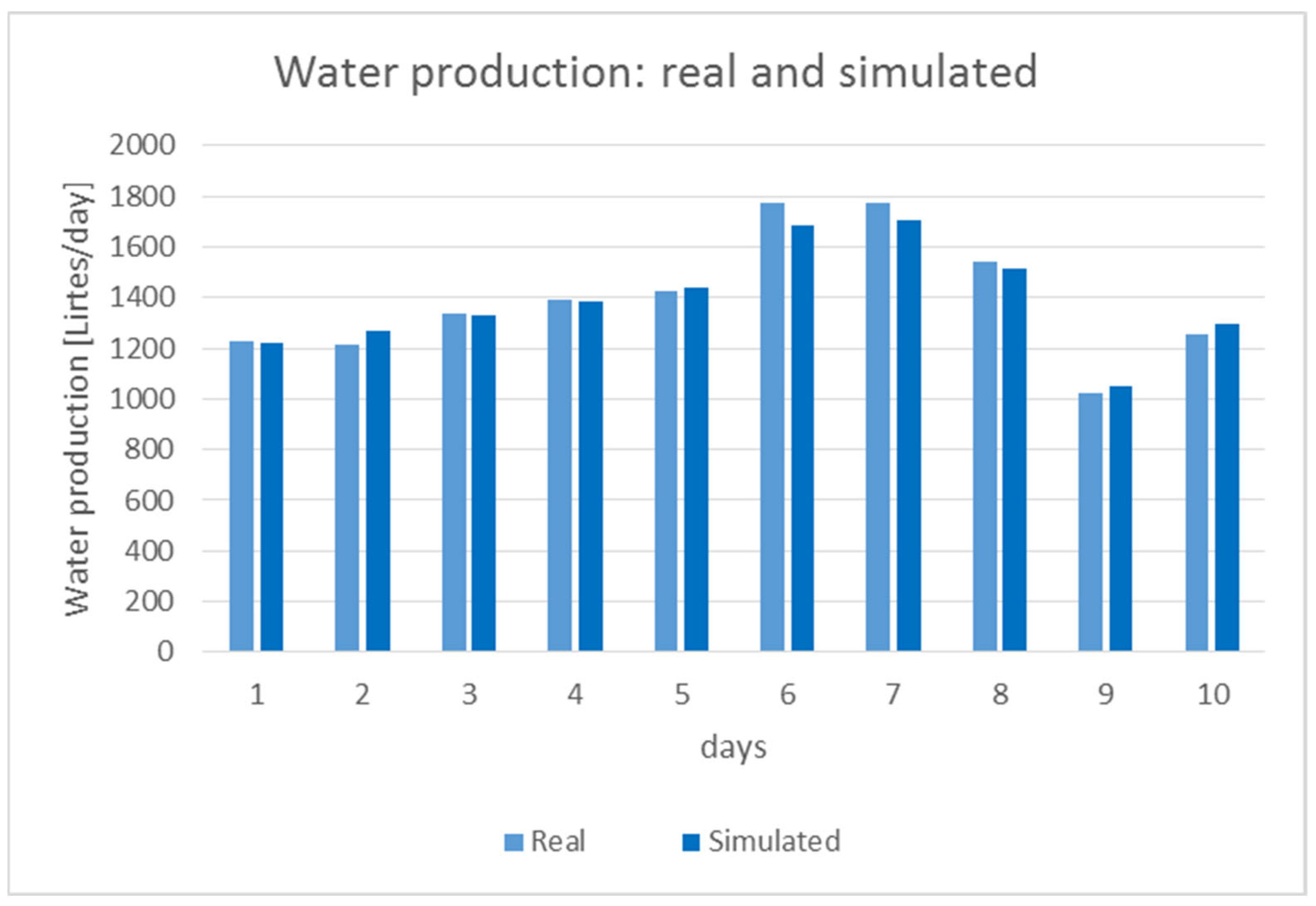
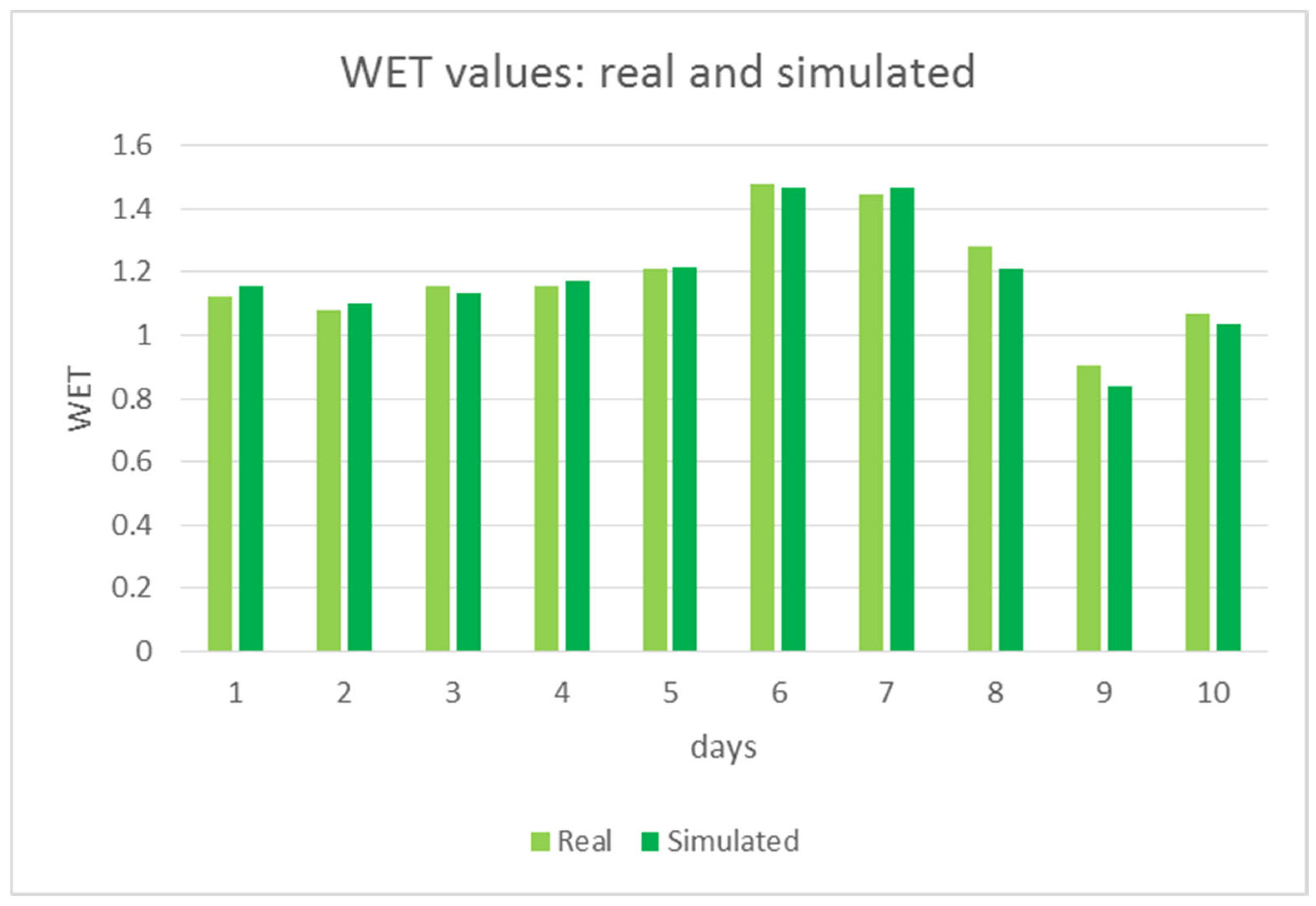


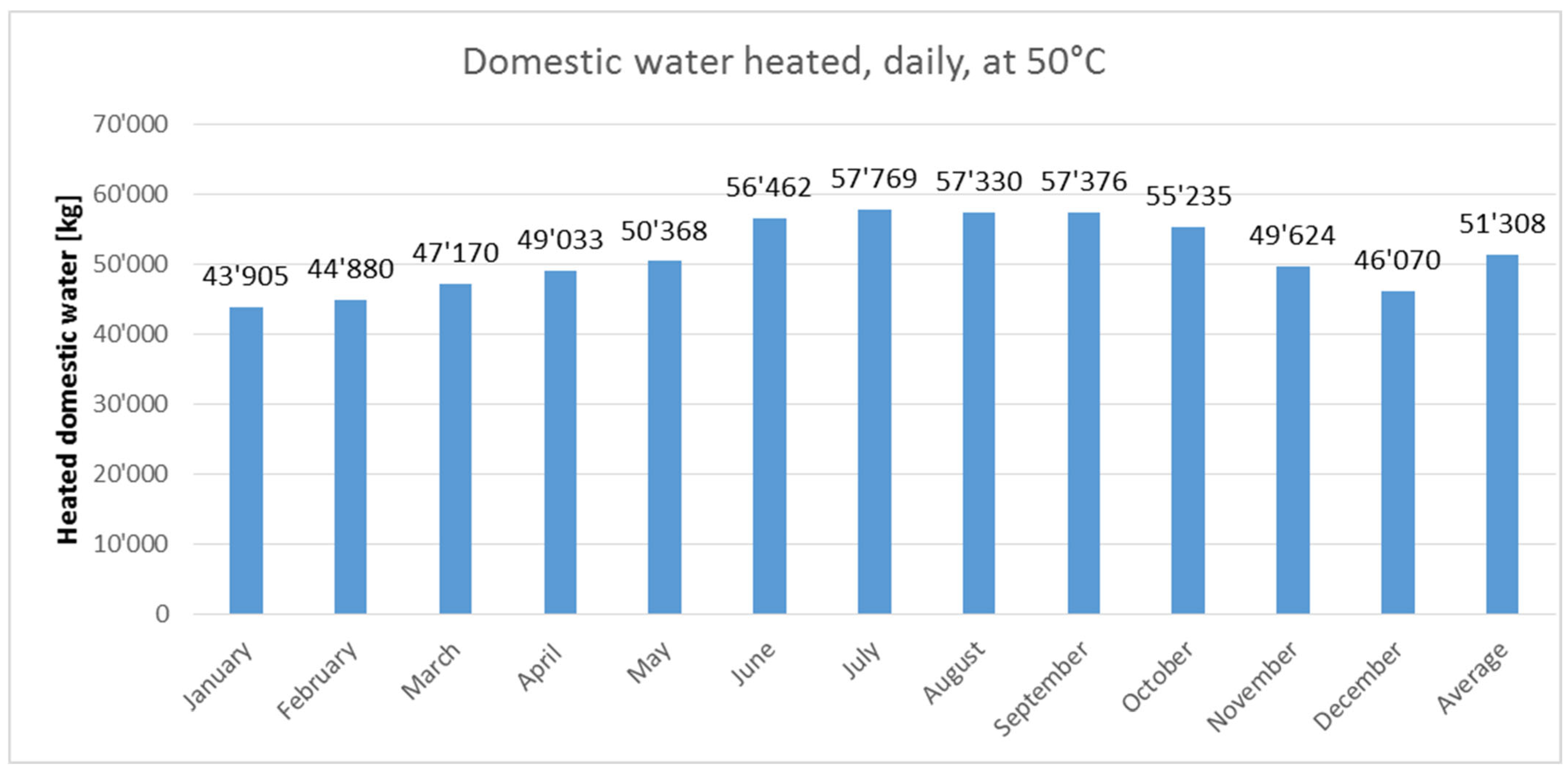
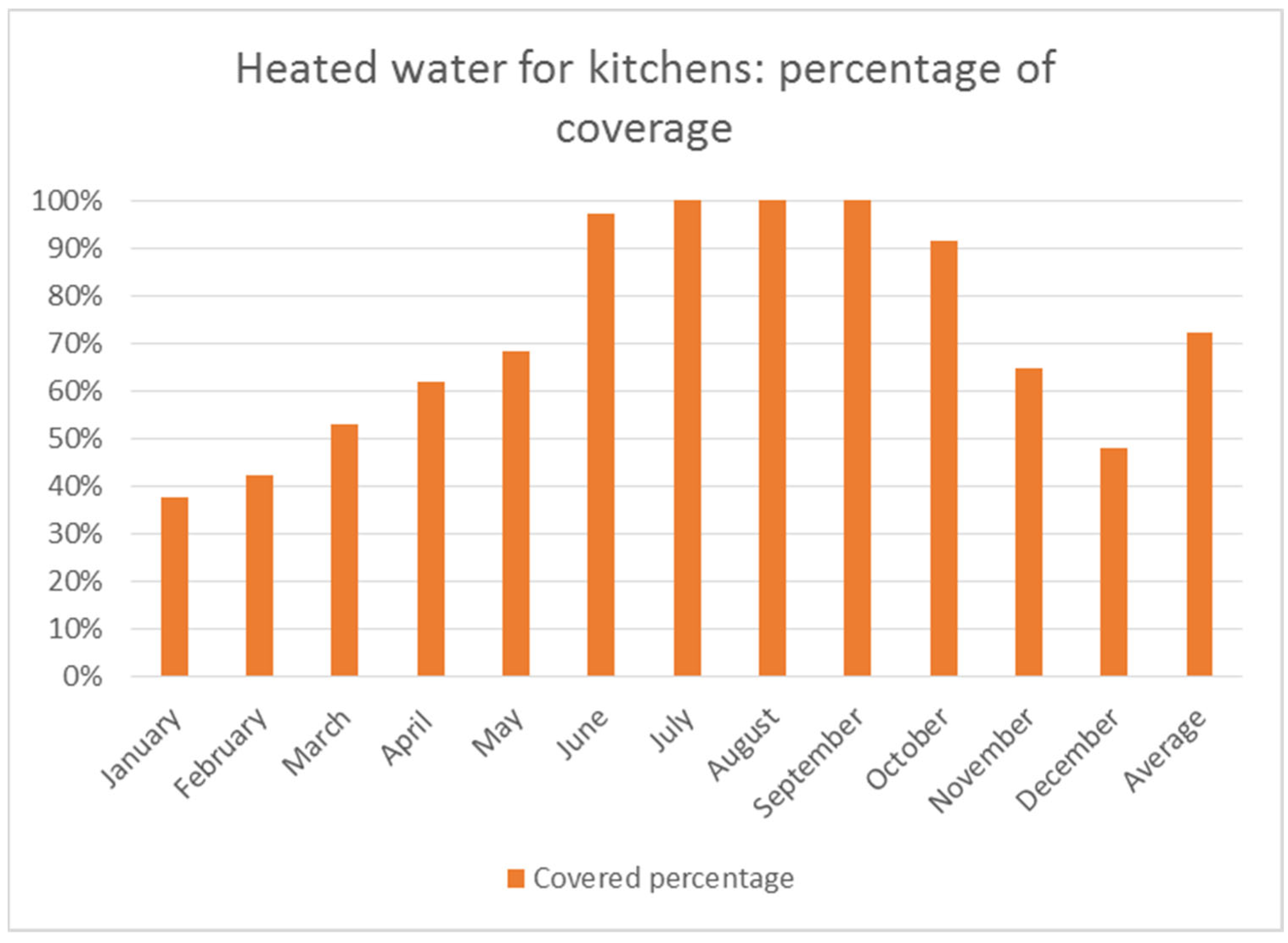

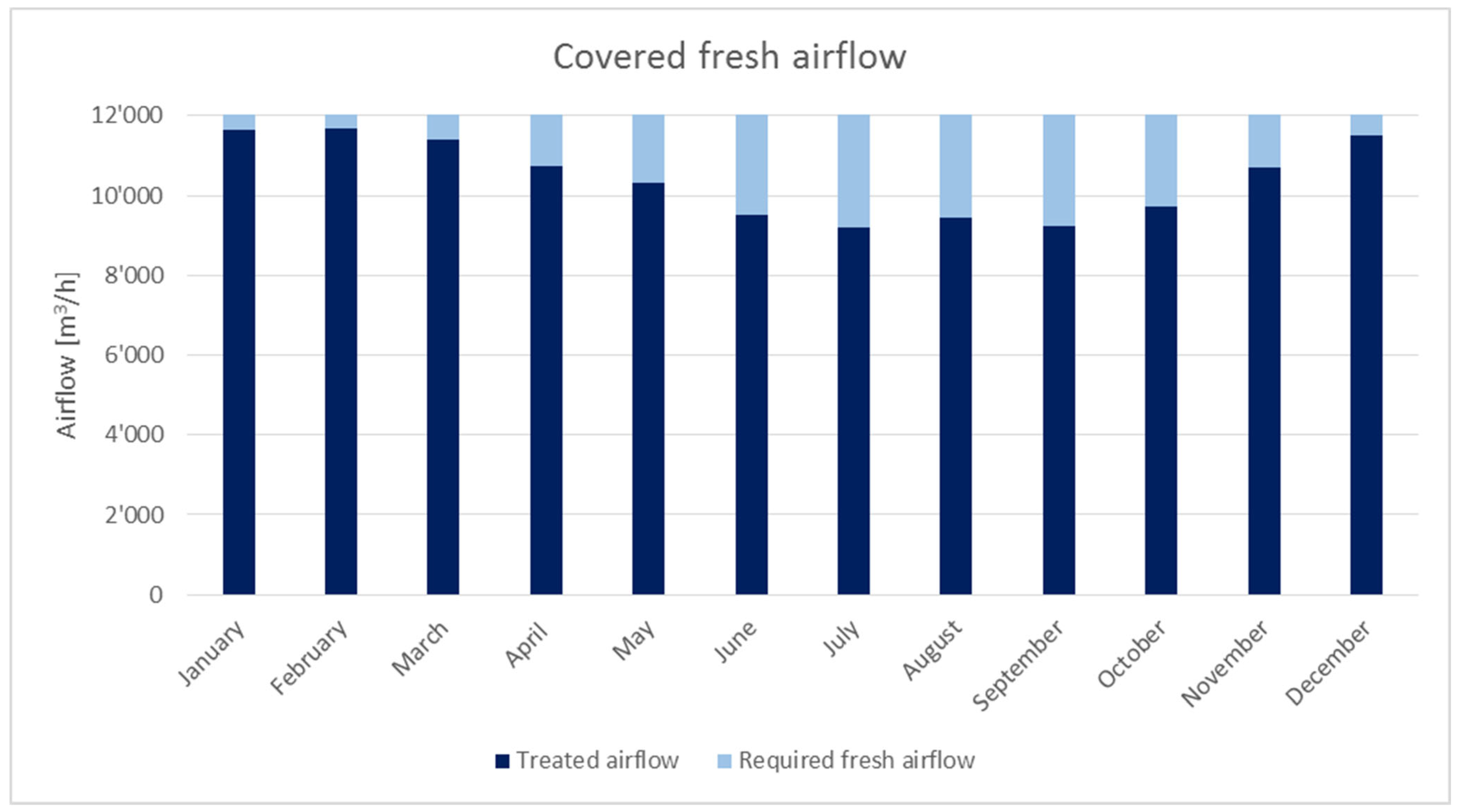

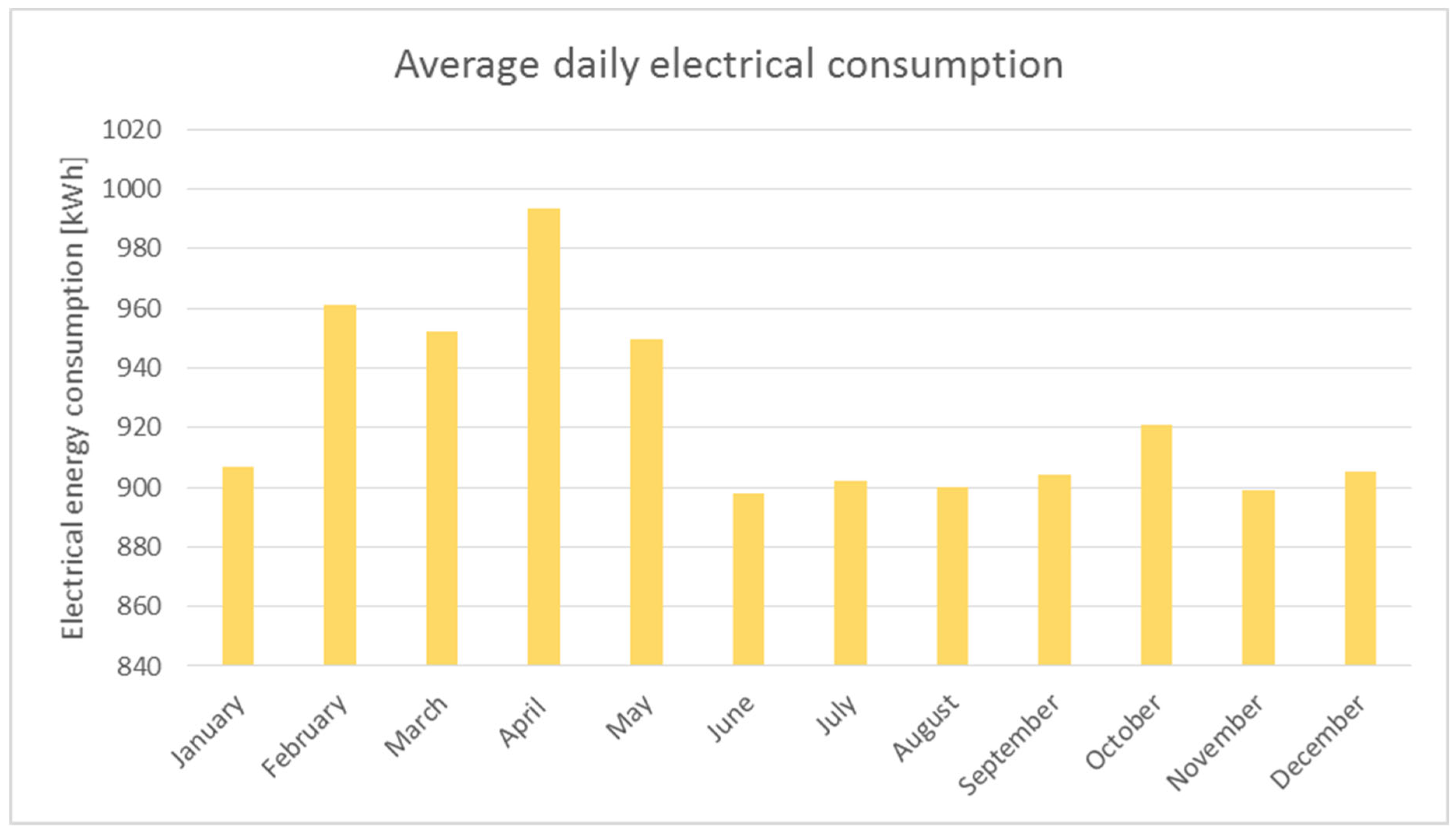

| Average | January | February | March | April | May | June | July | August | September | October | November | December |
|---|---|---|---|---|---|---|---|---|---|---|---|---|
| t (°C) | 20.6 | 21.7 | 24.4 | 28.5 | 32.8 | 34.2 | 37.0 | 36.8 | 34.4 | 31.2 | 26.5 | 22.3 |
| R. H. (%) | 59.7 | 56.5 | 53.2 | 46.6 | 39.5 | 48.8 | 44.6 | 44.6 | 51.5 | 54.4 | 53.7 | 57.4 |
| Physic Variable | Probe Type | Probe Error (in the Test Conditions) |
|---|---|---|
| Relative Humidity | Capacity hygrometer HTCT 01 | ±(1.3 + 0.003 measured r.h. value)% |
| Temperature | Resistance thermometer Pt100 | ±0.2 °C |
| Water flow | Oscillating piston water counter | ±2% of the read value |
| Water weight | Electronic Pressure scale | ±0.01 kg |
| Air Flow | Vane Anemometer | ±1% of the read value or ±2% 0.02 m/s |
| Energy | Integrated Power meter | 1% ± 2 words |
| Day of Test | Temperature | Relative Humidity | Water Production | Energy Consumption |
|---|---|---|---|---|
| (°C) | (%) | L/Day | kWh/Day | |
| 1 | 19.6 | 63.2 | 1229 | 772 |
| 2 | 20.6 | 61.7 | 1215 | 793 |
| 3 | 21.4 | 59.8 | 1335 | 813 |
| 4 | 21.7 | 60.4 | 1392 | 848 |
| 5 | 21.7 | 62.6 | 1423 | 827 |
| 6 | 20.1 | 74.6 | 1777 | 846 |
| 7 | 21 | 73.2 | 1775 | 864 |
| 8 | 20.7 | 53.6 | 1544 | 847 |
| 9 | 19.8 | 64.2 | 1022 | 795 |
| 10 | 19.6 | 63.2 | 1253 | 826 |
| Savings | Unitary Costs | Yearly Savings (EUR/Year) | |
|---|---|---|---|
| LPG (L/year) | 54,426.1 | 0.4484 EUR/L | 24,405 |
| Electricity due to boilers (kWh/year) | 634,509.5 | 0.10384 EUR/kWh | 65,887 |
| Electricity related to air conditioning | 190,259.5 | 19,757 | |
| Bottled water (L/year) | 570,614.8 | 0.165 EUR/L | 94,151 |
| Costs | Unitary Costs | Yearly costs (EUR/year) | |
| Integrated AWG machine electricity consumption (kWh/year) | 331,775.2 | 0.10384 EUR/kWh | 34,452 |
| Maintenance and consumables (EUR/year) | 12,000 | - | 12,000 |
| Net revenue (EUR/year) | 157,748 | ||
| Starting investment (EUR) | 292,163 | ||
| Pay Back Time (years) | 1.85 | ||
| Cash Inflow | EUR/Year |
|---|---|
| Electrical energy saving | 85,644.0 |
| LPG saving | 24,405.0 |
| Water saving | 94,151.0 |
| Cash outflow | EUR/year |
| Electrical consumption | −34,452.0 |
| Consumables and maintenance | −12,000.0 |
| Component replacement | −1461 |
Disclaimer/Publisher’s Note: The statements, opinions and data contained in all publications are solely those of the individual author(s) and contributor(s) and not of MDPI and/or the editor(s). MDPI and/or the editor(s) disclaim responsibility for any injury to people or property resulting from any ideas, methods, instructions or products referred to in the content. |
© 2023 by the authors. Licensee MDPI, Basel, Switzerland. This article is an open access article distributed under the terms and conditions of the Creative Commons Attribution (CC BY) license (https://creativecommons.org/licenses/by/4.0/).
Share and Cite
Cattani, L.; Cattani, P.; Magrini, A. Air to Water Generator Integrated System Real Application: A Study Case in a Worker Village in United Arab Emirates. Appl. Sci. 2023, 13, 3094. https://doi.org/10.3390/app13053094
Cattani L, Cattani P, Magrini A. Air to Water Generator Integrated System Real Application: A Study Case in a Worker Village in United Arab Emirates. Applied Sciences. 2023; 13(5):3094. https://doi.org/10.3390/app13053094
Chicago/Turabian StyleCattani, Lucia, Paolo Cattani, and Anna Magrini. 2023. "Air to Water Generator Integrated System Real Application: A Study Case in a Worker Village in United Arab Emirates" Applied Sciences 13, no. 5: 3094. https://doi.org/10.3390/app13053094
APA StyleCattani, L., Cattani, P., & Magrini, A. (2023). Air to Water Generator Integrated System Real Application: A Study Case in a Worker Village in United Arab Emirates. Applied Sciences, 13(5), 3094. https://doi.org/10.3390/app13053094







